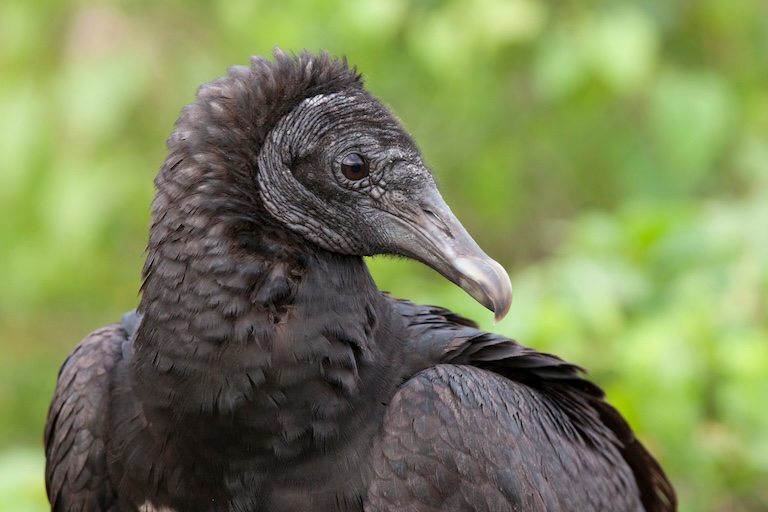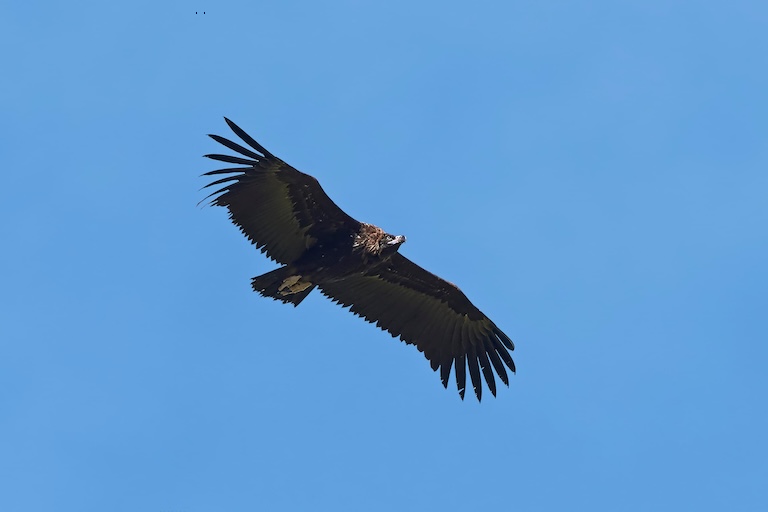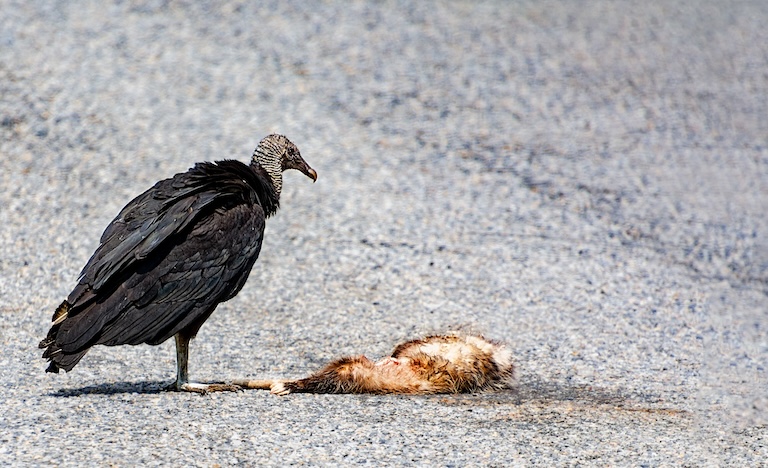Black Vulture Profile
Vultures all over the world are facing a multi-pronged assault from pollution, climate change, persecution, poisoning, habitat destruction and various other things that have seen some species drop by over 97%!
So, it’s nice to be able to talk about one that’s doing pretty well. The black vulture is one of the few species that’s currently benefiting from the dire straits we find our ecosystems in.

Black Vulture Facts Overview
| Habitat: | Open landscapes with woods or brush |
| Location: | North, Central and South America |
| Lifespan: | Up to 25 years |
| Size: | 74 cm (29 in) long, wingspan up to 1.67 m (66 in). |
| Weight: | Up to 3kg (6.6 lb), South American populations are smaller |
| Colour: | Glossy black plumage, with a featherless greyish-black head and neck. |
| Diet: | Primarily carrion, also eggs, small reptiles, newborn animals, scraps |
| Predators: | Eggs are vulnerable to mammalian predators |
| Top Speed: | Not recorded |
| No. of Species: | 1 |
| Conservation Status: | Least Concern (IUCN) |
Black vultures are the surprising cousins of African vultures, spanning a huge range across the Americas, feeding on more or less anything they come across.
These well-adapted gliding birds have keen eyesight and will follow others to a kill, only to chase them off it.
While they’re doing particularly well for a vulture species, they’re threatened by increasing air traffic and plastic pollution.
Interesting Black Vulture Facts
1. They’re vultures
This sounds like an obvious one, but the New World vultures have had a strange history of classification. It was thought until recently that they derived from Storks, moving toward carrion and evolving the classic vulture-like features independently of those found in Africa and Asia in the Accipitridae family.
And this is partly true. New World vultures have some remarkable adaptations that evolved entirely independently, yet distinctly similar to the vultures found in the Old World, but they are no longer thought to be related to storks.
The American vulture order, Cathartiformes, is now considered a sister-taxa to the Old World order, Accipitriformes, and in some circles, a redundant classification, since the family, Cathartidae, is sometimes placed within the Accipitriformes order entirely.
This latter grouping is arguably less accurate, but the raging debate between people with anoraks and spam sandwiches continues. Regardless, New World and Old World vultures are a lot more closely related than was once thought! 1 2

2. They’re built to soar
New world vultures have unique feather qualities that help prevent bacteria from breeding on them. They’re porous and aerated, preventing water from sitting on them, and they lack the interlocking hooks of other feathers, which may play a role in this, but certainly helps in their ability to fly.
This adaptation isn’t so much a flight aid, but a thermoregularity one, and allows the black vulture to soar at high altitudes without getting chilly.
The shape of the black vulture’s wing is a direct adaptation to soaring, though. Its aspect ratio is the most efficient for this, at the cost of flappability. As a result, this bird struggles a bit to take off, requiring a runway-like approach to a climbing takeoff.
Once up there, though, black vultures can stay for hours on a single wingbeat.
3. They’re great parents
When they’re not in the air, they’re often found in breeding pairs. Once a mate has been selected, they’ll usually stay together for many years and all seasons.
As monogamous pairs, they both take good care of their young, feeding them diligently for up to eight months after fledging, and staying in close contact with their family throughout their lives.
Large family groups roost together in the evening, defending against non-family members so as to keep their foraging sites a secret. 3
4. They’re tough
Their nesting sites vary from the tops of broken tree trunks to vacant buildings or even spots on the ground with adequate overhead cover.
While usually silent, Black Vultures may emit eerie ‘hissing’ sounds when feeling threatened and despite being smaller than Turkey Vultures, Black Vultures are highly aggressive, often driving away their much larger counterparts from carcasses and roosting sites.
Interactions like this involve pecking, biting, wing-pummeling, and foot-grappling. Interestingly, at carcasses, Black Vultures yield to Crested Caracaras and, in more southerly regions, to King Vultures and Andean Condors, but in other locations will put up a good fight.
5. They’ll eat anything
These vultures aren’t exactly picky eaters; they’re opportunistic scavengers, primarily feasting on carrion but commonly taking eggs, small reptiles, and newborn animals. They use both eyesight and the scent of other New World vultures to locate food, following one another to a kill.
They also scavenge at garbage dumps and consume a variety of waste items like fruit, fish, dung, and ripe plant material. They are also known to prey on newborn or weakened mammals, making them vital in ecosystem maintenance by disposing of carrion and curbing disease spread.
But it’s their indiscriminate feeding habits that are causing them trouble.

6. Including plastic
In a small study of 51 vultures that visited refuse piles, over 40% had ingested plastic, mainly low-density polyethylene and polystyrene.
High levels of harmful substances from the plastic were found inside these birds, causing stress in their bodies that affected their ability to stay healthy.
Even though scientists expected bigger pieces of plastic to be more harmful, they found that even small pieces were dangerous.
Plastic pollution is a growing problem that’s only just beginning to be taken seriously and affects nearly every animal on the planet. 4
7. But they’re doing well
Black Vultures have seen a notable but moderate increase in their populations over the years, growing by approximately 3.4% annually from 1966 to 2019.
This is a product of an attitude shift, away from the idea that these ecosystem clean-up crews were spreading diseases.
Despite current threats including airstrikes from planes and continued habitat loss, black vultures have adapted and actually expanded their range, benefitting from factors like increased roadkill availability from increasing road traffic and the warmer climates associated with climate change. 5
Black Vulture Fact-File Summary
Scientific Classification
| Kingdom: | Animalia |
| Phylum: | Chordata |
| Class: | Aves |
| Order: | Cathartiformes |
| Family: | Cathartidae |
| Genus: | Coragyps |
| Species: | Atratus |
Fact Sources & References
- Van Remsen (2008), “Separate Accipitriformes from Falconiformes”, Museum of Natural Science.
- Adam Dawid Urantówka (2021), “Mitogenomes of Accipitriformes and Cathartiformes Were Subjected to Ancestral and Recent Duplications Followed by Gradual Degeneration”, Oxford Academic.
- “Black Vulture”, CornellLab.
- Wallace Alves Cunha (2021), “From carrion-eaters to plastic material plunderers: Toxicological impacts of plastic ingestion on black vultures, Coragyps atratus (Cathartiformes: Cathartidae)”, Science Direct.
- “American Black Vulture”, IUCN Red List.
